Elekta ProKnow®
释放数据的力量,改进患者治疗
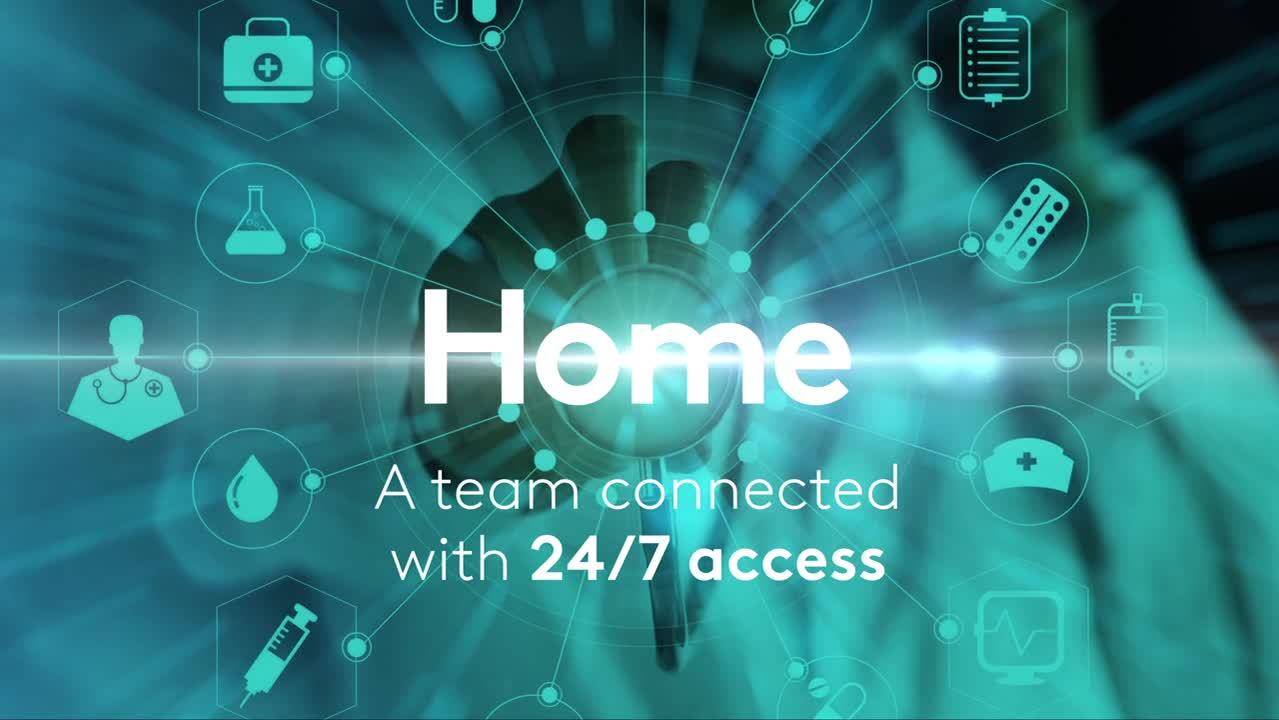
在全球范围内,放疗诊所每天都会产生大量数据。这些数据包含丰富的洞见,但由于缺少简洁直观的解决方案,这些数据始终无法为最有需要的专家所用。
Elekta ProKnow®*通过在基于网络的安全存储库中,集中管理所有数据,使数据变得易于获取,为您提供新的洞见。
同行评审和计划评估等工具可用于维护临床实践的质量和一致性,而自动勾画等自动化功能,确保了快速而又顺畅的工作流程。
*Elekta ProKnow尚未在所有市场上市。
提高治疗标准
Elekta ProKnow——创始人访谈
“提高工作流程效率的第一步是建立数据访问。”
Benjamin E. Nelms博士,ProKnow®创始人兼医科达顾问
2016年,Benjamin Nelms博士与其他人共同创建了ProKnow公司,旨在将“大数据”分析和基于云的重要功能带入放疗领域。
快来收听本播客,了解ProKnow的早期发展,及其近期在Elekta Planning Academy和Elekta Plan Challenge中的应用。
下载播客ProKnow,富有远见的数字化教学工具
位于墨尔本的皇家墨尔本理工大学对ProKnow感到非常满意,ProKnow是其用于教育本科生、提高标准、同时培养信心的一款工具。
更多信息长期健康结果的数据分析自动化

Lydia Wilson是美国圣裘德儿童研究医院的医学物理学家和教师。她向我们解释了对儿童癌症患者进行纵向研究的重要性,并说明了ProKnow如何帮助她的科室安排和改进数据采集。
快来了解有关Wilson博士使用ProKnow自动分析人口数据和简化临床任务的更多信息。 观看网络研讨会。.
精简临床试验管理
近30年来,Trans-Tasman Radiation Oncology Group(TROG)癌症研究中心一直在改进癌症患者的放疗方式。
TROG癌症研究中心与来自澳大利亚、新西兰和全球的研究人员合作,进行放疗相关的临床试验研究,旨在治疗多种类型的癌症,例如:乳腺癌、肺癌、前列腺癌、皮肤癌、头颈癌等。
目前已有超过1.45万名志愿者参与了TROG癌症研究试验。TROG已进行了100 多项临床试验,旨在帮助研究人员改进癌症治疗方法,以提高癌症患者的治疗效果和生活质量。
TROG癌症研究中心与澳大利亚和新西兰的70多家医院和癌症治疗中心展开了合作。
TROG癌症研究中心自2017年起开始使用ProKnow Systems™,来应对年度计划和轮廓勾画挑战。这些挑战通常与当前的试验相关。通常大约有150个治疗计划和超过25个国家/地区参与其中。
TROG Cancer Research最近开始在其网络中使用Elekta ProKnow。ProKnow可以优化数据分析、同行评审和整体试验管理的流程。此外,还有许多技术和临床焦点小组将ProKnow应用于各种项目。



澳大利亚全国粒子治疗研讨会上的知识分享和同行支持
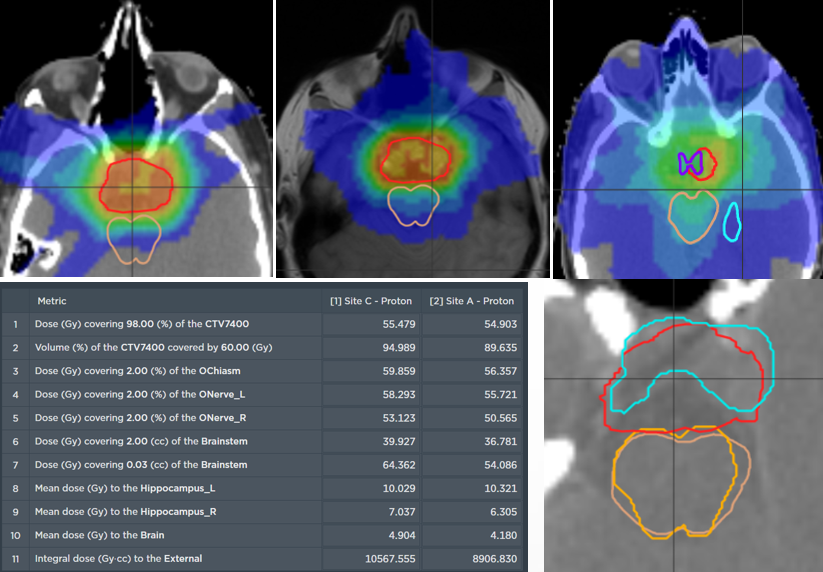
"ProKnow是研讨会取得成功的关键。ProKnow具有跨机构能力,这为我们提供了一个例子,展示了该系统如何为未来的全国粒子治疗转诊网络提供协助,特别是在多学科团队(MDT)审查质子和光子治疗计划比较方面。"
Scott Penfold,澳大利亚布拉格质子治疗与研究中心首席医学物理学家。
Knowledge sharing and peer-to-peer support at National Particle Therapy Symposium in Australia

"ProKnow was essential for the workshop's success. The multi-institutional capabilities of ProKnow provided centres with an example of how this system might assist in a future national particle therapy referral network, especially in MDT review of comparative proton-photon treatment plans."
Scott Penfold, Lead Medical Physicist, Australian Bragg Centre for Proton Therapy and Research.
Background
The Australian Bragg Centre for Proton Therapy and Research in Adelaide will provide proton radiation treatment to paediatric, adolescent and adult patients with rare cancer types. It will be Australia's first proton therapy unit and will be the focus for a national referral network. Patients will be triaged within this network through comparative planning and peer review.
The annual National Particle Therapy Symposium hosted by the South Australian Health and Medical Research Institute in 2021, aimed to bring together stakeholders from across Australia with an interest in particle therapy. The focus of the 2021 Symposium was development of a national framework to ensure equity of access to particle therapy.
As part of this meeting, a comparative planning workshop involving participants from four clinical sites across Australia was held. ProKnow provided the perfect platform to conduct this.
- TPS vendor agnostic Proton
- VMAT (modality independent)
- Cloud based access for remote collaboration
- Allows overlay of multiple plans
- Contouring and structure comparison capabilities
- Allows overlay of Multiple datasets (e.g. MRI)
- Comprehensive dosimetric analysis capabilities
"The use of Monaco allowed our comparative planning team to complete a very challenging base of skull IMPT plan. We now have a much better appreciation of the impressive capabilities of Monaco."
Scott Penfold, Lead Medical Physicist, Australian Bragg Centre for Proton Therapy and Research.
The case
The comparative planning workshop featured an extremely complex case. The four participating centres each created comparative proton-photon treatment plans. The CTV was abutting critical organs at risk such as optic chiasm, optic nerves, brainstem and hippocampi. In addition to this, the requirement for a high prescription dose meant that significant optimization trade-offs were required.
The Australian Bragg Centre team utilized MonacoPT to generate the proton therapy treatment plan and used unique features including constrained optimization, dynamic spot placements and Linear Energy Transfer (LET) analysis. The robustness optimization display also allowed the team to view approximate doses during optimization, not having to navigate through multiple windows.
Dose view
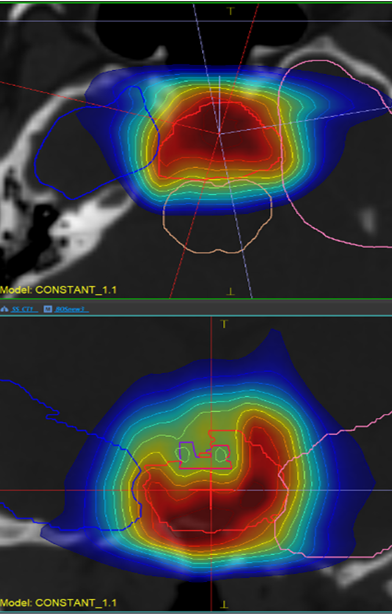
LET view
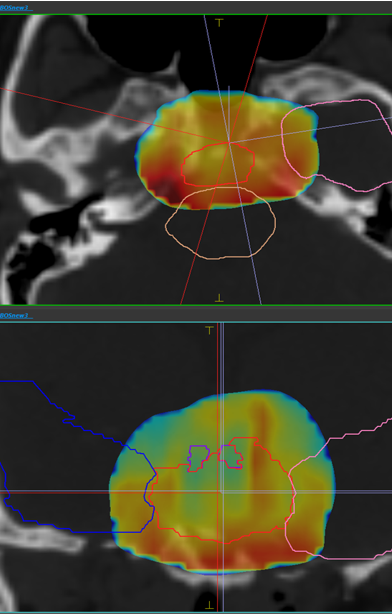


提高光子和质子治疗标准
ProKnow提供了一些工具,可以根据患者个人和患者群体的需求,在评分卡中定制临床指标和目标。评分卡有助于推动标准化、提高质量、消除不需要的变动,并证明报销的合理性。
该平台还支持有效性对比,帮助您基于数据,来制定决策,选择最适合您的技术、模式和协议。该解决方案支持所有计划系统和治疗模式,包括IMRT、VMAT、传统的3D外照射、质子、机器人、螺旋弧和近距离放疗。
Emma Viviers是美国佛罗里达大学健康质子治疗研究所的治疗计划医学物理学家。她的科室自2020年起一直在使用ProKnow,用于分析其临床历史数据。快来进一步了解她与该工具以及与Elekta ProKnow团队的互动吧。
Interview with Emma Viviers, Treatment Planning Medical Physicist, University of Florida Health Proton Therapy Institute, Florida, USA
Can you tell us about who you are and what you do?
My name is Emma Viviers. I started off my medical physics career and qualified initially in the UK, and then completed my residency in South Africa. I am currently a treatment planning medical physicist working at the University of Florida Health Proton Therapy Institute (UFPTI) and I've been there for the last five years.
What specific indications do you treat with proton therapy at your institution?
At UFPTI, we've treated patients from all over the world since we started. When we first opened 15 years ago, we were one of the very few proton facilities. We do treat with photons, proton double scatter and proton pencil beam scanning therapy. The most prevalent indications for protons would be left breast, head and neck, cranio-spinal, chordomas, prostate, lung, and pediatric cancers.
The reason for using protons for all those indications is because proton therapy can often reduce dose to adjacent organs at risk, where it can affect cardiac, lung or neurological function and have the potential to either impact life or otherwise severely affect the quality of life. That is the determining factor.
How did you first hear about ProKnow, and what is your experience with it so far?
The first experience I had with ProKnow was through the contouring accuracy programs. I found that was a really good tool to be able to learn how to contour unfamiliar structures.
As a group, we started testing ProKnow in 2020, to see if it was going to be of benefit to us, either clinically or research wise. And then, in the last year, we've basically been extensively uploading our data into ProKnow and using it for analysis of a lot of our historical clinical data.
We have approached it from different angles already.
We have had a small subset of patients with a particular reaction. We've gone back to look at the data and compare to all the other patients to see whether they were an outlier in any way. We've also used ProKnow to establish our baselines for future quality analysis, and we've been using the data and export function as well for research and publications.
Now we've got well over 2,000 patients in our database, which have been predominantly pediatric and breast patients. Having that number of pediatric patients in a single, clean database where we can do big data analysis really adds so much potential to be able to look for trends, to be able to help pediatric treatments going forward. There are not many proton sites with a lot of long-term history, so it is critical to have a solution that enables us to look at that wealth of data in an easy-to-analyze format.
Who uses ProKnow at your institution?
A very pleasant change for us going forward into using ProKnow is that the solution has enabled us to transfer the ownership of information towards the radiation oncologists. They now don't have to have a particular physicist available to be able to pull the information that they need. When it's one o'clock in the morning and they're lying awake, and they want an answer, they can quickly log into ProKnow and find their own answer from their own data. It started to be used predominantly by physics but going forward it's going to be used more by the radiation oncologists.
What was the first impression of the team when using the tool?
The first impression was largely on the accessibility of the software. Not everyone necessarily wanted to move away from an in-house software in which a lot of time and resources had been invested. Having a system like ProKnow that was so easy for everybody to access was a big help to being able to implement the change. We've had very positive feedback since then. It's very user friendly and extremely accessible. Any physician offered ProKnow jumps in and uses it immediately.
How do you see ProKnow being used in the future at your institution?
We are using ProKnow very much as a pristine clinical tool. But what we envisage in the future is that we will have a research workspace and a clinical workspace so that the one does not corrupt the other. This is a helpful feature of ProKnow, to be able to keep those workspaces separated.
In chart rounds we have also been discussing looking at plan quality, to ensure that we are not just getting a plan that will pass our clinical tolerances but looking at getting the best possible plan from the modality that we are using. ProKnow has helped us to not just identify which patients benefit from proton therapy, but also which patients would benefit from pencil beam scanning versus double scattered. And this is something that in the new year we will be looking at, using ProKnow to improve our plan quality for each modality.
What one feature of ProKnow could you not live without?
The accessibility. The fact that any of our clinical personnel with logins can access the clinical data that has been assigned to them from any device. We've even had collaborators from overseas, such as the NHS in the UK, with which we're able to share data with a click of a button. That gives everybody the ability to answer their own clinical research questions at the touch of a button and with a secured cloud solution. We don't need to be trying to transfer. To securely transfer this data—over a TB of information—in any other way would have been prohibitive.
Anything that exceeded your expectations?
What exceeded our expectations was the customer support. I've never worked with a company that is so willing to listen to what your concerns are and to see it, every time that you contact them for customer support, as a means to improve their software. They see whatever shortfall we may identify, not only as something that they need to assist us with, but to improve the platform for all users.
We have had some very fundamental changes that we needed to be able to implement the solution clinically—features like the relative dose function. From a programming point of view, I understand that was a fundamental change that the ProKnow engineers went away and made happen for us. It's really encouraging to see when we do have any sort of suggestions or ideas that they are very accommodating and implement a rapid improvement in the software with each release.
You really have a fantastic team there, the way that they interact with us. From a software point of view as well as from a personal point of view, it has really been a pleasure working the team.
通过基于人工智能的自动轮廓勾画,最大限度地提高运营效率
人工智能程序与算法简介
快来观看医科达物理与研究副总裁Virgil Willcut探讨人工智能在放疗中的重要性。
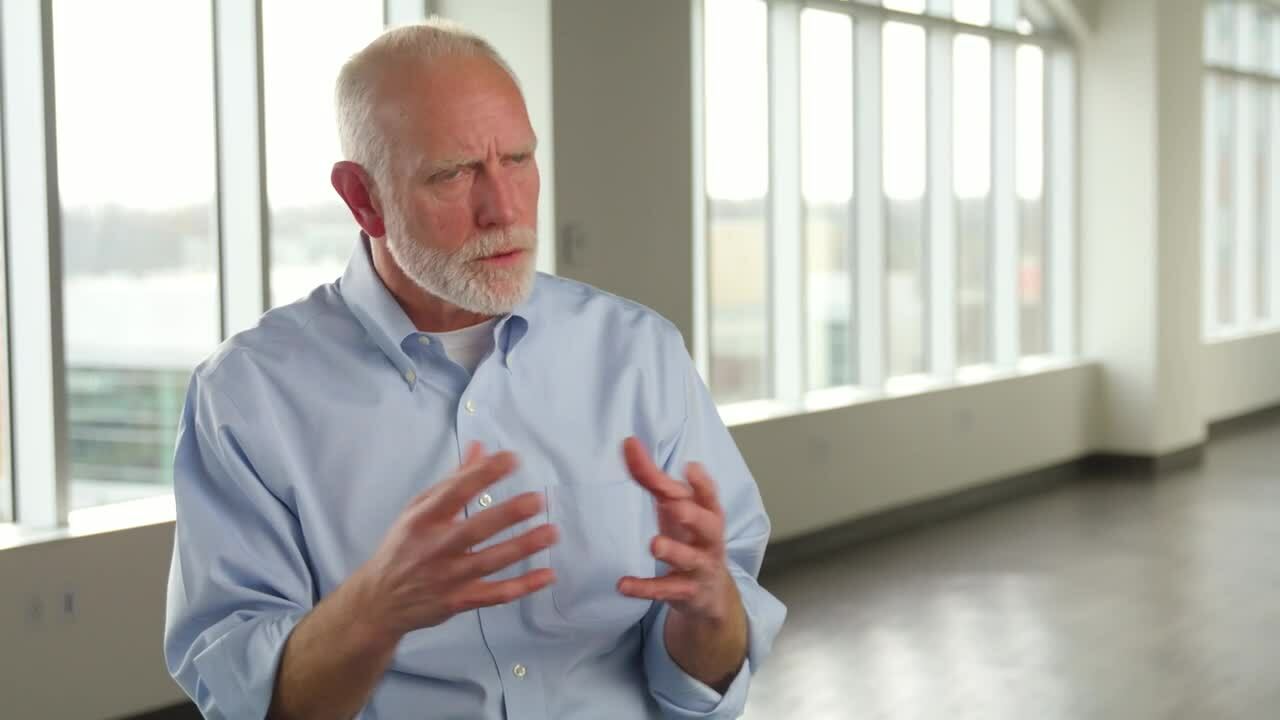

"使用ProKnow基于人工智能的自动轮廓勾画功能,对我来说是一次非常愉悦的体验。轮廓的生成和审查非常快,而且这个工具十分简单易懂。ProKnow这种基于云的模块也非常有助于高效部署解决方案和实施培训。"
本杰明·李博士,MD, MBA - 加州大学旧金山分校(UCSF)任职,担任Rayos Contra Cancer执行总裁及主任。